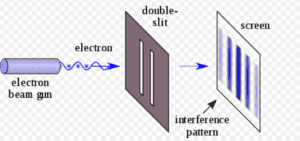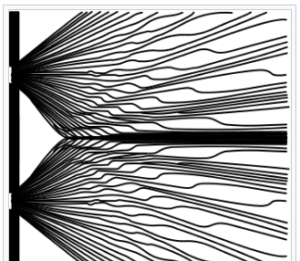An interpretation of quantum mechanics describes the nature of reality in the quantum realm. Quantum mechanics is a set of equations which can be used describe the behavior of quantum particles. There is general agreement among quantum physicists as to the experimental results in the field of quantum mechanics and the equations which describe these results. However, there is not yet a consensus among physicists as to the explanation for these results. There are over 20 different interpretations of what is going on in physical reality. These interpretations include Copenhagen, de Broglie-Bohm, Many Worlds, and others.
For example, here are two interpretations of the Double Slit Experiment:
- Interpretation 1: An electron is shot from an electron gun towards a barrier perforated with two tiny slits. The electron should go through the slits and travel on to a detection screen, where it will make a tiny mark. An equation (the “wave function”) describes a set of probabilities as to where a particle is likely to be detected on the detection screen. The particle is detected as a localized particle in a random position on the detection screen.

Double Slit Experiment. One electron is shot from an electron gun repeatedly, yielding an interference pattern.
[Image source: [Image source: modification of https://en.wikipedia.org/wiki/Double-slit_experiment]
However, with repetitions of the experiment, the particles will outline a wave interference pattern (fringes) on the detection screen. The probabilities calculated by the equation predicts the fringe pattern. But this pattern could be created only if the particle were to go through both slits simultaneously and “interfere with itself.” For a particle, traveling through both slits simultaneously would be paradoxical. By definition, a particle is localized.
As we cannot, by definition, detect the particle after leaving the electron gun and before detection, we can say nothing about the nature of reality prior to detection of the particle on the screen. While the mathematics of quantum mechanics is very useful, the quantum realm appears paradoxical and so, has no physical reality. This is the Copenhagen Interpretation. The Copenhagen Interpretation is the original interpretation of quantum mechanics and continues to be supported by many physicists. It is the interpretation usually taught in universities.
- Interpretation 2: A real physical wave goes through both slits. It carries a particle through only one of the slits. Ultimately, the particle is detected on a detection screen. The position of the particle on the detection screen, far from being random, is determined by its initial position and velocity. This is the Bohmian Interpretation. The Bohmian Interpretation builds on work by Nobel Laureate in physics, Louis de Broglie. De Broglie’s work was further developed by David Bohm in the 1950’s and 1960’s.


